Related Research Articles

DoñaMaría Eugenia Ignacia Agustina de Palafox y Kirkpatrick, 19th Countess of Teba, 16th Marchioness of Ardales, known as Eugénie de Montijo, was Empress of the French from her marriage to Emperor Napoleon III on 30 January 1853 until the Emperor was overthrown on 4 September 1870.
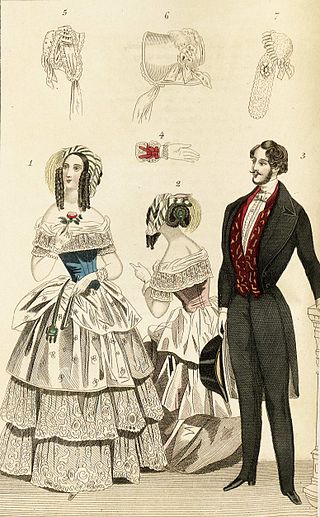
Victorian fashion consists of the various fashions and trends in British culture that emerged and developed in the United Kingdom and the British Empire throughout the Victorian era, roughly from the 1830s through the 1890s. The period saw many changes in fashion, including changes in styles, fashion technology and the methods of distribution. Various movement in architecture, literature, and the decorative and visual arts as well as a changing perception of gender roles also influenced fashion.
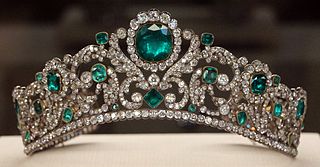
A tiara is a jeweled head ornament. Its origins date back to ancient Greece and Rome. In the late 18th century, the tiara came into fashion in Europe as a prestigious piece of jewelry to be worn by women at formal occasions. The basic shape of the modern tiara is a (semi-)circle, usually made of silver, gold or platinum, and richly decorated with precious stones, pearls or cameos.
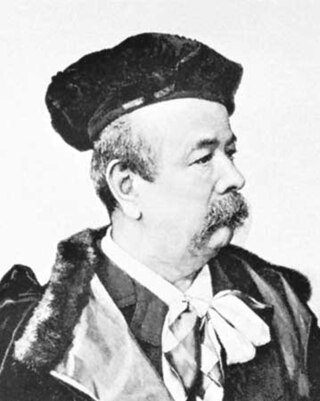
Charles Frederick Worth was an English fashion designer who founded the House of Worth, one of the foremost fashion houses of the 19th and early 20th centuries. He is considered by many fashion historians to be the father of haute couture. Worth is also credited with revolutionising the business of fashion.

Franz Xaver Winterhalter was a German painter and lithographer, known for his flattering portraits of royalty and upper-class society in the mid-19th century. His name has become associated with fashionable court portraiture. Among his best known works are Empress Eugénie Surrounded by her Ladies in Waiting (1855) and the portraits he made of Empress Elisabeth of Austria (1865).
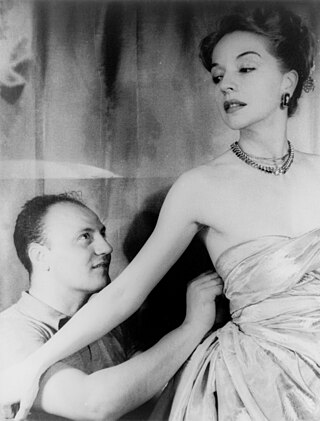
A dressmaker, also known as a seamstress, is a person who makes clothing for women, such as dresses, blouses, and evening gowns. Dressmakers were historically known as mantua-makers, and are also known as a modiste or fabrician.
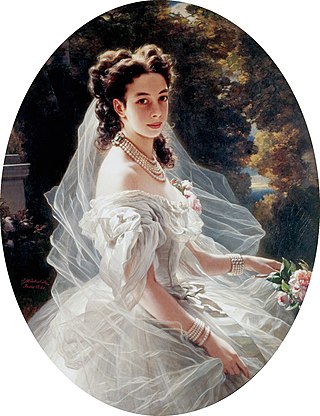
Pauline Clémentine Marie Walburga, Princess of Metternich-Winneburg zu Beilstein was a famous Austrian socialite, mainly active in Vienna and Paris. Known for her great charm and elegance as well as for her social commitment, she was an important promoter of the work of the German composer Richard Wagner and the Czech composer Bedřich Smetana. She was also instrumental to the creation of the haute couture industry.

Elizabeth Florence Emanuel is a British fashion designer who is best known for designing, with her former husband David Emanuel, the wedding dress worn by Lady Diana Spencer on her wedding to Prince Charles in 1981. Since then Elizabeth has developed her own label and worked in costume design for airlines, cinema, pop video and television productions, as well as providing a couture service to some of the world's most famous women.

History of fashion design refers specifically to the development of the purpose and intention behind garments, shoes ,accessories, and their design and construction. The modern industry, based around firms or fashion houses run by individual designers, started in the 19th century with Charles Frederick Worth who, beginning in 1858, was the first designer to have his label sewn into the garments he created.
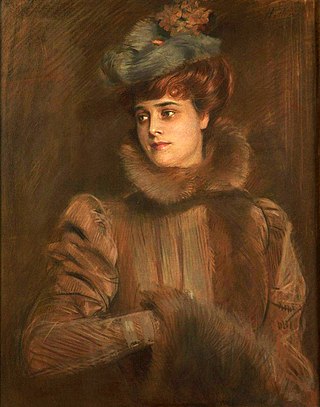
Madame Louise Chéruit (1866-1955), born Louise Lemaire, often erroneously called Mme Madeleine Chéruit, was among the foremost couturiers of her generation, and one of the first women to control a major French fashion house. Her salon operated in the Place Vendôme in Paris under the name Chéruit from 1906 to 1935. Chéruit is best remembered today as the subject of a number of portraits by Paul César Helleu, with whom she conducted an affair before opening her couture house and for the appearance of her name in two celebrated works of literature, Marcel Proust's Remembrance of Things Past (1910) and Evelyn Waugh's Vile Bodies (1930). Her name is also frequently associated with the fashion photography of Edward Steichen whose favorite model, Marion Morehouse, often wore gowns from the house of Chéruit for Vogue magazine in the 1920s. One particular Steichen image has become iconic: Morehouse in a jet-beaded black net Chéruit dress, first published in 1927.

Caroline Reboux was a Parisian milliner and French fashion designer. She opened her first boutique at 23 rue de la paix in Paris in 1865, which she continued to operate throughout her life. Reboux opened other shops in Paris and London starting in 1870. She trained other milliners who became famous in their own right, including American milliner Lilly Daché and French milliner Rose Valois. Reboux's most famous shop was located at 9 Avenue Matignon in Paris, which carried on operating after her death for almost three decades under the direction of Lucienne Rabaté known as "Mademoiselle Lucienne" the most famous parisian milliner at that time.

The House of Worth was a French fashion house that specialized in haute couture, ready-to-wear clothes, and perfumes. It was founded in 1858 by English designer Charles Frederick Worth. It continued to operate under his descendants until 1952 and closed in 1956. The House of Worth fashion brand was revived in 1999.
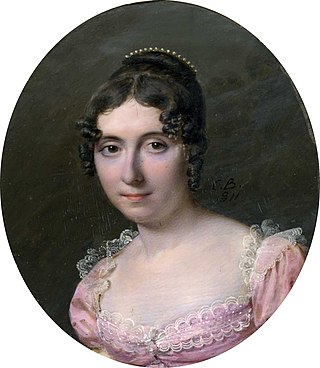
Henriette Vincent (1786–1834) was an early 19th-century botanical painter at the French court.

A Eugénie hat is a small women's hat that is usually worn tilted forwards over the face, or it may be angled low over one eye. Typically, it is made of velvet or felt, although a variety of materials may be used. The classic design also has a plume of feathers, although other trims may be used.
Louis Hippolyte Leroy (1763–1829) was a French fashion merchant who founded the House of Leroy, one of the foremost fashion houses of the early 19th century First Empire Paris. He is known as the favorite fashion trader and the official fashion designer of empress Josephine de Beauharnais. He was very successful and also provided dresses for several other royal and Princely courts in Europe during the early 19th century.
Madame Palmyre also called Mademoiselle Palmyre, was a French fashion designer couturier.
Madame Victorine (19th-century), was a French fashion designer couturier.
Madame Herbault, was a French fashion designer (milliner).
Madame Virot (1826-1911) was a French fashion designer milliner. Alongside Caroline Reboux, she was one of the two most famous hat designers in Paris during the second half of the 19th-century.

A fashion icon or fashion leader is a influential person who introduces new styles which spread throughout fashion culture and become part of fashion. They initiate a new style which others may follow. They may be famous personalities such as political leaders, celebrities, or sports personalities. For example, during the 1960s, Jackie Kennedy was a great fashion icon for American women, and her style became a sign of wealth, power, and distinction; and her famous Pink Chanel suit is one of the most referenced and revisited of all of her items of clothing. Twiggy was an It girl, she was a teenaged model and fashion icon of Swinging Sixties.
References
- ↑ Penny McCracken: Women Artists and Designers in Europe Since 1800: An Annotated Bibliography (Bibliography of Women Artists & Designers in Europe Since 18)
- ↑ Valerie Steele: Women of Fashion: Twentieth-century Designers, Rizzoli International, 1991
- ↑ Philippe Perrot: Fashioning the Bourgeoisie: A History of Clothing in the Nineteenth Century
- ↑ Granström, Alvar, Kvinnor och krinoliner: en mode- och sedeskildring från krinolinmodets tid, Carlsson, Stockholm, 1990
- ↑ James Laver: Manners and Morals in the Age of Optimism, 1848-1914, 1966